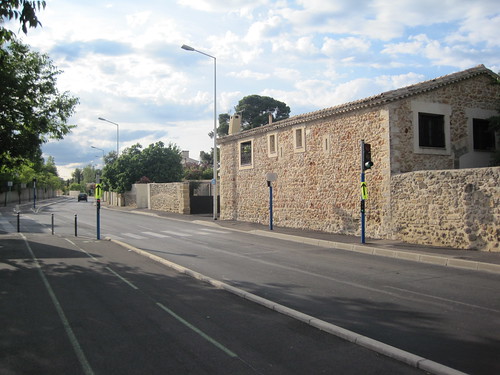I've just uploaded my first zc.buildout recipe to PyPI: http://pypi.python.org/pypi/zgeo.recipe.openlayers/. It's a recipe for creating custom builds of OpenLayers.js. Based on Kai Lautaportti's hexagonit.recipe.cmmi, it does some of the same useful tricks: working on either OpenLayers distributions (by url option) or local checkouts (by path option), and code patching (by patch-options and patches). Put a list of files in the include option, following the OpenLayers documentation for custom build profiles, and crank out the custom compressed files.
I've put it to use in a project that implements nothing other than the Atom publishing protocol. No layers, no WxS, no strategies. My custom profile buildout configuration is very simple:
[buildout]
parts = openlayers-bingo
[openlayers-bingo]
recipe = zgeo.recipe.openlayers
path = ${buildout:directory}/src/openlayers
include =
OpenLayers/Format/Atom.js
OpenLayers/Format/GeoJSON.js
Running it generates the output you may have seen before:
$ bin/buildout -c buildout.cfg
Uninstalling openlayers-bingo.
Installing openlayers-bingo.
openlayers-bingo: Using local source directory: /Users/seang/code/ol-recipes/src/openlayers
Merging libraries.
Importing: OpenLayers.js
Importing: OpenLayers/BaseTypes.js
Importing: OpenLayers/SingleFile.js
Importing: OpenLayers/Util.js
Importing: OpenLayers/BaseTypes/Class.js
Importing: OpenLayers/Format/Atom.js
Importing: OpenLayers/Format/GeoJSON.js
Resolution pass 1...
Importing: OpenLayers/BaseTypes/Bounds.js
Importing: OpenLayers/BaseTypes/Element.js
Importing: OpenLayers/BaseTypes/LonLat.js
Importing: OpenLayers/BaseTypes/Pixel.js
Importing: OpenLayers/BaseTypes/Size.js
Importing: OpenLayers/Console.js
Importing: OpenLayers/Feature/Vector.js
Importing: OpenLayers/Format/GML/v3.js
Importing: OpenLayers/Format/JSON.js
Importing: OpenLayers/Format/XML.js
Importing: OpenLayers/Geometry/LineString.js
Importing: OpenLayers/Geometry/MultiLineString.js
Importing: OpenLayers/Geometry/MultiPoint.js
Importing: OpenLayers/Geometry/MultiPolygon.js
Importing: OpenLayers/Geometry/Point.js
Importing: OpenLayers/Geometry/Polygon.js
Importing: OpenLayers/Lang/en.js
Resolution pass 2...
Importing: OpenLayers/Feature.js
Importing: OpenLayers/Format.js
Importing: OpenLayers/Format/GML/Base.js
Importing: OpenLayers/Geometry.js
Importing: OpenLayers/Geometry/Collection.js
Importing: OpenLayers/Geometry/Curve.js
Importing: OpenLayers/Geometry/LinearRing.js
Importing: OpenLayers/Lang.js
Resolution pass 3...
Importing: OpenLayers/Format/GML.js
Importing: OpenLayers/Format/WKT.js
Importing: OpenLayers/Marker.js
Importing: OpenLayers/Popup/AnchoredBubble.js
Resolution pass 4...
Importing: OpenLayers/Events.js
Importing: OpenLayers/Icon.js
Importing: OpenLayers/Popup/Anchored.js
Resolution pass 5...
Importing: OpenLayers/Popup.js
Re-ordering files...
Exporting: OpenLayers/SingleFile.js
Exporting: OpenLayers.js
Exporting: OpenLayers/BaseTypes.js
Exporting: OpenLayers/BaseTypes/Class.js
Exporting: OpenLayers/Util.js
Exporting: OpenLayers/BaseTypes/Element.js
Exporting: OpenLayers/BaseTypes/Size.js
Exporting: OpenLayers/Console.js
Exporting: OpenLayers/Icon.js
Exporting: OpenLayers/Popup.js
Exporting: OpenLayers/BaseTypes/Bounds.js
Exporting: OpenLayers/BaseTypes/LonLat.js
Exporting: OpenLayers/BaseTypes/Pixel.js
Exporting: OpenLayers/Lang.js
Exporting: OpenLayers/Popup/Anchored.js
Exporting: OpenLayers/Events.js
Exporting: OpenLayers/Format.js
Exporting: OpenLayers/Lang/en.js
Exporting: OpenLayers/Popup/AnchoredBubble.js
Exporting: OpenLayers/Format/JSON.js
Exporting: OpenLayers/Format/XML.js
Exporting: OpenLayers/Marker.js
Exporting: OpenLayers/Feature.js
Exporting: OpenLayers/Feature/Vector.js
Exporting: OpenLayers/Format/WKT.js
Exporting: OpenLayers/Geometry.js
Exporting: OpenLayers/Geometry/Collection.js
Exporting: OpenLayers/Geometry/Point.js
Exporting: OpenLayers/Geometry/MultiPoint.js
Exporting: OpenLayers/Geometry/Curve.js
Exporting: OpenLayers/Geometry/LineString.js
Exporting: OpenLayers/Geometry/LinearRing.js
Exporting: OpenLayers/Geometry/MultiLineString.js
Exporting: OpenLayers/Geometry/Polygon.js
Exporting: OpenLayers/Geometry/MultiPolygon.js
Exporting: OpenLayers/Format/GML.js
Exporting: OpenLayers/Format/GeoJSON.js
Exporting: OpenLayers/Format/GML/Base.js
Exporting: OpenLayers/Format/GML/v3.js
Exporting: OpenLayers/Format/Atom.js
Total files merged: 40
Compressing using jsmin.
Adding license file.
Writing to OpenLayers.js.
Done.
And yields these files, ready to be copied or linked to a location for production:
$ ls -l parts/openlayers-bingo/
total 360
-rw-r--r-- 1 seang staff 180958 Jun 3 15:35 OpenLayers.js
drwxr-xr-x 25 seang staff 850 Jun 3 15:23 img
drwxr-xr-x 3 seang staff 102 Jun 3 15:23 theme
Oh, and collective.checkdocs is great for finding bugs in your package's long descriptions.



Comments
Re: We're hosting the Tour
Author: Jason E. Rist
I can't tell you how jealous I am of you right now...
Re: We're hosting the Tour
Author: James Fee
Boy that looks awful. I have no idea how you'll be able to survive there. ;)